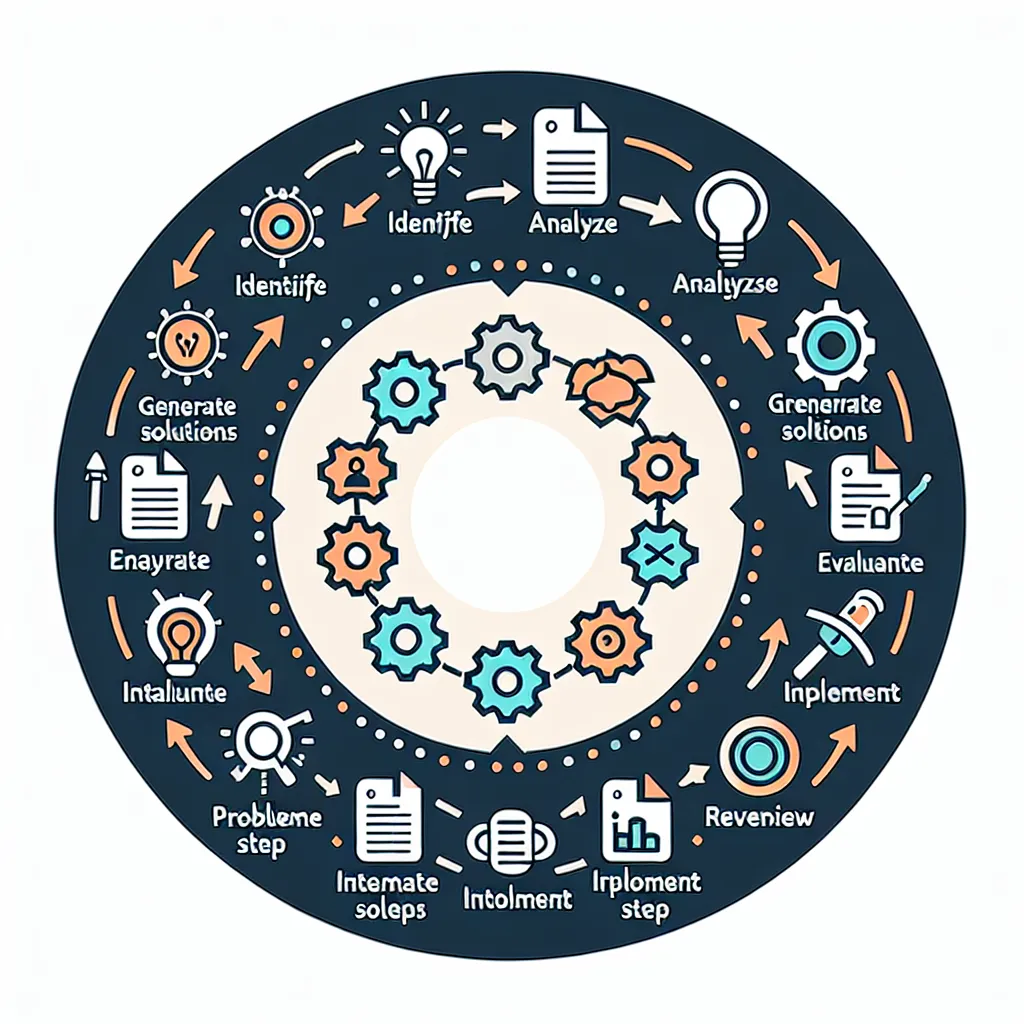In today’s competitive job market, being able to effectively communicate your problem-solving skills in English is crucial. Whether you’re interviewing for a position in a multinational company or seeking to advance in your current role, articulating your approach to problem-solving can set you apart from other candidates. This article will guide you through the process of explaining your problem-solving methodology in English, providing you with valuable insights and practical tips to impress your interviewer.
Understanding the Importance of Problem-Solving Skills
Problem-solving is a critical skill that employers value across all industries. It demonstrates your ability to think critically, analyze situations, and develop effective solutions. When you can explain your problem-solving approach clearly in English, you showcase not only your analytical skills but also your communication abilities – both of which are highly sought after in the global workplace.
 Problem Solving Diagram
Problem Solving Diagram
The Interviewer’s Perspective on Problem-Solving Skills
When assessing candidates’ problem-solving abilities, interviewers typically look for:
- Analytical thinking: How well you can break down complex issues.
- Creativity: Your ability to think outside the box.
- Decision-making: How you choose the best course of action.
- Implementation skills: Your capacity to put solutions into practice.
- Resilience: How you handle setbacks and adapt to challenges.
Understanding these aspects will help you tailor your responses to highlight your strengths in each area.
Crafting Your Problem-Solving Narrative
To effectively explain your approach to problem-solving, it’s helpful to structure your response using the STAR method (Situation, Task, Action, Result). This framework allows you to present your problem-solving skills in a clear and concise manner.
Example Response Using the STAR Method
Interviewer: “Can you walk me through your approach to problem-solving?”
Candidate: “Certainly. I follow a structured approach to problem-solving that I’ve refined over time. Let me illustrate with a specific example:
Situation: In my previous role as a project manager, we encountered a significant delay in our software development timeline due to unexpected technical issues.
Task: My responsibility was to address the delay and get the project back on track without compromising quality or exceeding the budget.
Action: I approached this problem methodically:
- First, I gathered all relevant information by meeting with the development team and stakeholders.
- I analyzed the root causes of the delay using a fishbone diagram.
- Then, I brainstormed potential solutions with the team, encouraging creative thinking.
- We evaluated each solution based on feasibility, impact, and resource requirements.
- After selecting the most promising approach, I developed a detailed action plan.
- Throughout the implementation, I monitored progress closely and made adjustments as needed.
Result: By following this approach, we were able to resolve the technical issues and complete the project with only a two-week delay, as opposed to the initial estimate of two months. This experience reinforced the importance of systematic problem-solving and effective communication in project management.”
This response demonstrates a clear, step-by-step approach to problem-solving while providing a concrete example of its application and success.
Tips for Handling Unexpected Questions
Sometimes, you may encounter questions about problem-solving that are outside your immediate experience. Here are some strategies to handle such situations:
- Stay calm and take a moment to think before responding.
- If you don’t have a direct experience, consider hypothetical scenarios or draw from related experiences.
- Focus on your general problem-solving methodology rather than specific technical details.
- Be honest about your limitations, but emphasize your eagerness to learn and adapt.
For example: “While I haven’t encountered that exact situation, I believe my problem-solving approach would be similar. I’d start by gathering all available information, consult with experts if necessary, analyze the options, and then develop and implement a solution based on the best available data.”
Common Mistakes to Avoid When Discussing Problem-Solving
When explaining your problem-solving approach, be wary of these common pitfalls:
- Being too vague: Provide specific examples and details to make your explanation concrete and believable.
- Overcomplicating your response: Keep your explanation clear and concise.
- Focusing solely on the solution: Remember to emphasize the process, not just the outcome.
- Neglecting to mention teamwork: Problem-solving often involves collaboration, so highlight your ability to work with others.
- Failing to show adaptability: Demonstrate how you adjust your approach based on the specific situation.
To avoid these mistakes, practice your responses beforehand and ask for feedback from colleagues or mentors.
Follow-up Questions and Sample Answers
Be prepared for these common follow-up questions:
-
Q: “How do you prioritize when facing multiple problems?”
A: “I assess the urgency and potential impact of each issue. I then create a prioritized list, addressing high-impact, time-sensitive problems first while delegating or scheduling less critical tasks.” -
Q: “Can you describe a time when your initial solution to a problem didn’t work?”
A: “In a previous project, our first approach to optimizing a database didn’t yield the expected results. I quickly acknowledged this, re-evaluated our assumptions, and worked with the team to develop an alternative solution, which ultimately succeeded.” -
Q: “How do you handle disagreements when solving problems in a team?”
A: “I believe in open communication. I listen to all perspectives, focus on objective data, and work towards a consensus. If necessary, I’m not afraid to make a decision, but I always explain my reasoning to maintain team cohesion.” -
Q: “What resources do you typically use when solving complex problems?”
A: “I rely on a combination of internal expertise, industry best practices, and data analysis tools. I also value networking with colleagues and, when appropriate, seeking insights from external experts or professional forums.” -
Q: “How do you ensure you’ve considered all aspects of a problem before implementing a solution?”
A: “I use techniques like mind mapping and stakeholder analysis to ensure a comprehensive view. I also seek input from diverse team members and consider potential long-term implications before finalizing a solution.”
By preparing for these follow-up questions, you’ll be able to provide more depth to your problem-solving approach and demonstrate your readiness for various scenarios.
Conclusion
Explaining your approach to problem-solving in English is an essential skill for job interviews and career advancement. By understanding the key components of effective problem-solving, structuring your responses using the STAR method, and avoiding common pitfalls, you can articulate your skills confidently and impressively. Remember to practice your responses and stay adaptable to different types of questions. With these strategies, you’ll be well-prepared to showcase your problem-solving abilities in any professional setting.
For more tips on acing your English job interviews, check out our articles on how to answer “What makes you a good fit for this job?” in English and how to talk about your strengths in English. These resources will help you further refine your interview skills and increase your chances of success.




